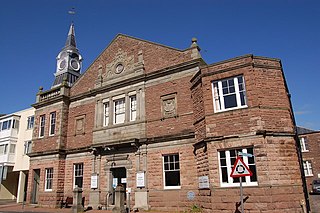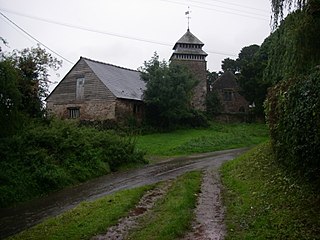
The Hendre, in Rockfield, is the only full-scale Victorian country house in the county of Monmouthshire, Wales. The ancestral estate of the Rolls family, it was the childhood home of Charles Rolls, the motoring and aviation pioneer and the co-founder of Rolls-Royce. Constructed in the Victorian Gothic style, the house was developed by three major architects, George Vaughan Maddox, Thomas Henry Wyatt and Sir Aston Webb. It is located in the civil parish of Llangattock-Vibon-Avel, some 4 miles (6.4 km) north-west of the town of Monmouth. Built in the eighteenth century as a shooting box, it was vastly expanded by the Rolls family in three stages during the nineteenth century. The house is Grade II* listed and is now the clubhouse of the Rolls of Monmouth Golf Club. The gardens and landscape park, mainly laid out by Henry Ernest Milner in the later 19th century, are designated Grade II* on the Cadw/ICOMOS Register of Parks and Gardens of Special Historic Interest in Wales.

Llangattock-Vibon-Avel is a rural parish and former community, now in the community of Whitecastle in Monmouthshire, south-east Wales, in the United Kingdom. It is located 5 miles (8.0 km) west of Monmouth and some 13 miles (21 km) east of Abergavenny, just off the B4233 old road between the two. Villages within the former community include Llangattock itself, Skenfrith, Rockfield, and Newcastle.

Rockfield is a small village in the community of Whitecastle, Monmouthshire, Southeast Wales. It is located beside the River Monnow, about 2 miles (3.2 km) north-west of Monmouth, at the junction of the B4233 to Abergavenny and the B4347 to Grosmont. Rockfield Studios is situated just south of the village.

John Etherington Welch Rolls was a High Sheriff of Monmouthshire, art collector, Deputy Lieutenant and Justice of the Peace. Rolls was President of, and co-founded the Monmouth Show.

Monmouth Methodist Church is located in Monmouth, south east Wales. It is set well back from St James Street between buildings. Designed by George Vaughan Maddox and built in 1837, it retains its original galleries, organ loft and sophisticated pulpit.

The Rolls Hall, Whitecross Street, Monmouth, Monmouthshire is a Victorian hall, now public library, donated to the town in celebration of Queen Victoria's Golden Jubilee by John Rolls, the future Lord Llangattock. It is a Grade II listed building as of 8 October 2005, and is one of 24 buildings on the Monmouth Heritage Trail.

George Vaughan Maddox was a nineteenth-century British architect and builder, whose work was undertaken principally in the town of Monmouth, Wales, and in the wider county. Working mainly in a Neo-Classical style, his extensive output made a significant contribution to the Monmouth townscape. The architectural historian John Newman considers that Monmouth owes to Maddox "its particular architectural flavour. For two decades from the mid-1820s he put up a sequence of public buildings and private houses in the town, in a style deft, cultured, and only occasionally unresolved." The Market Hall and 1-6 Priory Street are considered his "most important projects".

Georgiana, Lady Llangattock,, born Georgiana Marcia Maclean and after her marriage termed Georgiana Marcia Rolls, was a socialite, benefactor and an enthusiast for Horatio Nelson and associated naval heroes. She was the wife of John Rolls, 1st Baron Llangattock, a Victorian landowner, Member of Parliament and agriculturalist. She and her husband lived at The Hendre, a Victorian country house north of Monmouth.

The Rolls family were substantial landowners and benefactors in and around Monmouth in south-east Wales. The ascent of the family to the aristocracy was through marriage. A prominent member of the family was Charles Stewart Rolls, who co-founded the Rolls-Royce car manufacturing company.

Whitecross Street is a historic street in the town centre of Monmouth, Monmouthshire, Wales. It was in existence by the 15th century, and appears as Whit crose on the 1610 map of the town by cartographer John Speed. It runs in an east-west direction, between Church Street and St James Square. It has been suggested that the street takes its name from a plague cross. Whitecross Street is lined with numerous listed buildings.

Monk Street is an historic street in the town of Monmouth, Monmouthshire, Wales. A portion of it was in existence by the 14th century, and appears on the 1610 map of the town by cartographer John Speed. It runs in a north-south direction, extending northward from its intersection with Whitecross Street. The name of the street relates to the nearby Priory, as well as the gate which was originally on this road and provided part of the town's defences, Monk's Gate. Monk Street is lined with numerous listed buildings.

The Masonic Hall is a grade II listed building on Monk Street in Monmouth, Monmouthshire, Wales. It was designed by architect George Vaughan Maddox. The building is believed to mark the site of Monk's Gate, part of the original defences of the town of Monmouth. Before its 1846 conversion to the Masonic Hall, the building served as the Monk Street Theatre. After more than 150 years of housing the Loyal Monmouth Lodge No. 457, the Masonic Hall sustained fire and smoke damage from suspected arson. The Lodge of Freemasons housed in the building is the oldest surviving Masonic Lodge in Monmouthshire.

The Nelson Rooms is a grade II listed building in Monmouth, Monmouthshire, Wales. It is in the historic Glendower Street and Agincourt Street neighbourhood, within the medieval town walls. The building initially served as a gymnasium and was a gift from Lady Llangattock to the town of Monmouth. In 1924, after the benefactor's death, it reopened as the Nelson Museum, and showcased the collection of memorabilia related to Admiral Horatio Nelson that had been amassed by the baroness. The Nelson Museum moved to new quarters at the Market Hall in 1969. The former gymnasium and museum is now an apartment building.
Major Alexander Rolls was a native of Swansea, Glamorganshire, Wales. A member of the renowned Rolls family of The Hendre at Llangattock-Vibon-Avel near Monmouth, Monmouthshire, his life in public service included four terms as Mayor of Monmouth. He was an officer in the Royal Monmouthshire Militia and the 4th Royal Irish Dragoon Guards. Rolls married twice; the widower's second marriage was to a divorcée, English actress Helen Barry.

John Rolls of The Hendre was a native of Bermondsey, in Southwark, London, Surrey, England. A member of the renowned Rolls family of The Hendre at Llangattock-Vibon-Avel near Monmouth, Monmouthshire, Wales, he undertook the first of several expansions of the mansion. The Hendre was also the childhood home of his great-grandson Charles Stewart Rolls, aviation pioneer and co-founder of Rolls-Royce Limited. John Rolls was a Justice of the Peace, as well as a Lieutenant Colonel of the Loyal Southwark Volunteer Infantry.
John Rolls was a native of Bermondsey, Southwark, London, Surrey, England. A member of the Rolls family of The Grange in Bermondsey and The Hendre, Monmouthshire, he married heiress Sarah Coysh. That marriage was instrumental in furthering both the fortune and the social rank of the Rolls family. In addition to serving a term as High Sheriff of Monmouthshire, Rolls was a Justice of the Peace.

Sarah Coysh was the heiress to the estates of the Coysh, Allen, and James families. Her marriage to John Rolls (1735–1801) illustrates one of the methods by which the renowned Rolls family of Monmouthshire, Wales, and London, England, accumulated and improved their properties and advanced their social rank during the eighteenth and nineteenth centuries.

St Cenedlon's is a parish church in the village of Rockfield, Monmouthshire, Wales. The dedication to St Cenedlon is unusual and the history of the saint is obscure. Some sources suggest that she was a daughter of Brychan king of Brycheiniog while others identify her as the wife of King Arthfael ab Ithel, king of Glywysing. The existing church dates from the Middle Ages but only the tower remains from that period. After the English Reformation, the surrounding area of north Monmouthshire became a refuge for Catholics and Matthew Pritchard (1669-1750), Roman Catholic bishop and Vicar Apostolic of the Western District is buried at the church. By the mid-19th century the church was in ruins and a complete reconstruction was undertaken by the ecclesiastical architects John Pollard Seddon and John Prichard in around 1860. St Cenedlon's is an active parish church in the Diocese of Monmouth. It is designated by Cadw as a Grade II listed building.

The Church of St Cadoc, Llangattock Vibon Avel, Monmouthshire is a parish church of medieval origins which was heavily restored in the 19th century. The estate church of The Hendre, it is closely connected with the Rolls family and the grave of Charles Stewart Rolls, the motoring and aviation pioneer, is located in the churchyard. The church is a Grade II* listed building and is now in the care of the Friends of Friendless Churches.

The Church of St Maughan in St. Maughans, Monmouthshire, Wales, is a parish church with its origins in the 13th or 14th century. It was reconstructed in the mid 19th century by John Pollard Seddon for John Etherington Welch Rolls of The Hendre in 1865. It remains an active parish church and is a Grade II* listed building.
















